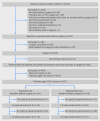Patient reported outcomes in patients undergoing arthroscopic partial meniscectomy for traumatic or degenerative meniscal tears: comparative prospective cohort study
- PMID: 28153861
- PMCID: PMC5421436
- DOI: 10.1136/bmj.j356
Patient reported outcomes in patients undergoing arthroscopic partial meniscectomy for traumatic or degenerative meniscal tears: comparative prospective cohort study
Abstract
Objectives: To compare patient reported outcomes from before surgery to 52 weeks after surgery between individuals undergoing arthroscopic partial meniscectomy for traumatic meniscal tears and those for degenerative meniscal tears.
Design: Comparative prospective cohort study.
Setting: Four public orthopaedic departments in the Region of Southern Denmark. Participants were recruited between 1 February 2013 and 31 January 2014, and at one of the original four hospitals from 1 February 2014 to 31 January 2015.
Participants: Individuals selected from Knee Arthroscopy Cohort Southern Denmark, aged 18-55, and undergoing arthroscopic partial meniscectomy for a traumatic or degenerative meniscal tear (defined by a combination of age and symptom onset).
Interventions: Both participant groups underwent arthroscopic partial meniscectomy for a meniscal tear, with operating surgeons recording relevant information on knee pathology. Patient reported outcomes were recorded via online questionnaires.
Main outcome measures: Primary outcome was the average between-group difference in change on four of five subscales of the knee injury and osteoarthritis outcome score (KOOS). The four subscales covered pain, symptoms, sport and recreational function, and quality of life (KOOS4). A 95% confidence interval excluding differences greater than 10 KOOS points between groups was interpreted as absence of a clinically meaningful difference. Analyses adjusted for age, sex, and body mass index.
Results: 397 eligible adults (42% women) with a traumatic or degenerative meniscal tear (n=141, mean age 38.7 years (standard deviation 10.9); n=256, 46.6 years (6.4); respectively) were included in the main analysis. At 52 weeks after arthroscopic partial meniscectomy, 55 (14%) patients were lost to follow-up. Statistically, participants with degenerative meniscal tears had a significantly larger improvement in KOOS4 scores than those with traumatic tears (adjusted between-group difference -5.1 (95% confidence interval -8.9 to -1.3); P=0.008). In the analysis including KOOS4 score at all time points, a significant time-by-group interaction was observed in both the unadjusted (P=0.025) and adjusted analysis (P=0.024), indicating better self-reported outcomes in participants with degenerative tears. However, the difference between groups was at no time point considered clinically meaningful.
Conclusions: These results question the current tenet that patients with traumatic meniscal tears experience greater improvements in patient reported outcomes after arthroscopic partial meniscectomy than patients with degenerative tears.Trial registration ClinicalTrials.gov identifier NCT01871272.
Published by the BMJ Publishing Group Limited. For permission to use (where not already granted under a licence) please go to http://group.bmj.com/group/rights-licensing/permissions.
Conflict of interest statement
Competing interests: All authors have completed the ICMJE uniform disclosure form at
Figures


Comment in
-
Meniscal resection may not benefit patients with traumatic meniscal tears.Evid Based Med. 2017 Oct;22(5):193. doi: 10.1136/ebmed-2017-110720. Epub 2017 Aug 1. Evid Based Med. 2017. PMID: 28765141 No abstract available.
References
-
- Khan M, Evaniew N, Bedi A, Ayeni OR, Bhandari M. Arthroscopic surgery for degenerative tears of the meniscus: a systematic review and meta-analysis. CMAJ 2014;186:1057-64. 10.1503/cmaj.140433 pmid:25157057. - DOI - PMC - PubMed
-
- Thorlund JB, Juhl CB, Roos EM, Lohmander LS. Arthroscopic surgery for degenerative knee: systematic review and meta-analysis of benefits and harms. BMJ 2015;350:h2747 10.1136/bmj.h2747 pmid:26080045. - DOI - PMC - PubMed
-
- Poehling GG, Ruch DS, Chabon SJ. The landscape of meniscal injuries. Clin Sports Med 1990;9:539-49.pmid:2379242. - PubMed
-
- Englund M, Guermazi A, Gale D, et al. Incidental meniscal findings on knee MRI in middle-aged and elderly persons. N Engl J Med 2008;359:1108-15. 10.1056/NEJMoa0800777 pmid:18784100. - DOI - PMC - PubMed
-
- Englund M. The role of the meniscus in osteoarthritis genesis. Rheum Dis Clin North Am 2008;34:573-9. 10.1016/j.rdc.2008.05.009 pmid:18687273. - DOI - PubMed
Publication types
MeSH terms
Associated data
LinkOut - more resources
Full Text Sources
Other Literature Sources
Medical
